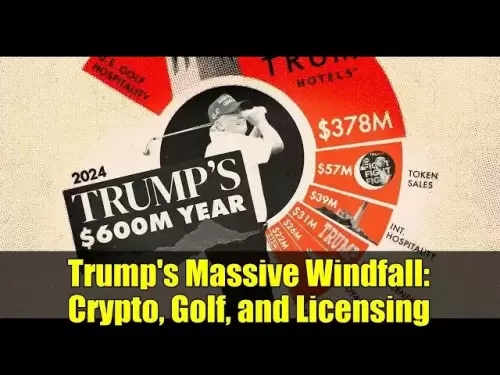 |
|
 |
|
 |
|
 |
|
 |
|
 |
|
 |
|
 |
|
 |
|
 |
|
 |
|
 |
|
 |
|
 |
|
 |
|
Cryptocurrency News Articles
The U.S. May Be On the Verge of Ditching Its Penny
May 23, 2025 at 01:35 am
Grab your coin purse: The U.S. may be on the verge of ditching its penny. The U.S. Treasury is reportedly gearing up to stop
The U.S. may be on the verge of ditching its penny.
According to a Thursday report from The Wall Street Journal, the Treasury Department is set to stop putting new one-cent coins into circulation by early next year.
The Treasury reportedly made its final order of penny blanks this month, a spokesperson told the WSJ. The Mint will now only produce pennies until it runs out of blanks, which the spokesperson said will take about three to four months. The change will also mean businesses will have to round up or down prices to the nearest five cents, the spokesperson added.
The Treasury and the U.S. Mint, which is responsible for making the nation’s coins, did not immediately respond to Nexstar’s requests for comment.
The report comes months after the Department of Government Efficiency (DOGE) set its sights on the penny and President Donald Trump called on the Treasury Department to stop minting new one-cent coins, calling them “wasteful.”
It costs roughly 3.69 cents to make one penny, according to the latest data from the U.S. Mint. Last year also marked the 19th year in a row that the penny — and the nickel — “remained above face value” when it comes to production costs.
Earlier this month, a bipartisan bill to halt penny production was introduced by Senators Jeff Merkley (D-Ore.) and Mike Lee (R-Utah). It was one of a handful of bills that have been brought forth since Trump’s comments on the one-cent coin.
“I’m pleased to see the Treasury Department taking a page from my ‘Make Sense, Not Cents Act,'” Sen. Lee said in a statement shared with Nexstar. “Each penny costs four cents to make, so cutting this waste will save the American taxpayer over $85 million every year.”
Merkley did not immediately respond to Nexstar’s requests for comment regarding Thursday’s report.
The move comes as Congress is also working on legislation to regulate the Federal Reserve and oversee the national money, according to the Constitution.
The U.S. would not be the first country to ditch its lowest-denomination coin. (And it wouldn't even be the first time we've stopped producing a coin.)
What happened when Canada ditched its penny?
Canada said farewell to its penny in the early 2010s as the cost of making the coin had risen in recent years. At the time, however, it cost Canada 1.6 cents to produce one new penny, vastly less than what the U.S. is paying now, but enough to spur the government to do away with the coin.
The Royal Canadian Mint worked with financial institutions and charities to begin collecting the nation’s pennies, essentially putting the distribution process in reverse, Alex Reeves, then the Senior Manager of Communications for the Mint, told PBS News in 2014. Old pennies were turned in and melted down to extract their valuable metals.
Without a one-cent coin, cash transactions had to change. Cash purchases are now rounded to the nearest nickel: For instance, a $19.82 purchase becomes $19.80 while $19.83 becomes $19.85. Payments with checks or debit or credit cards are not rounded.
The U.S. appears likely to do the same, a Treasury spokesperson indicated to the Wall Street Journal.
Will pennies become valuable collector’s items?
The short answer is probably not.
Ten years after Canada stopped minting the penny, collectors said the novelty value of the coin did not skyrocket. Experts at All About Coins in Salt Lake City recently told Nexstar’s KTVX they don’t foresee a spike in the value of Abraham Lincoln’s coin, either.
“I don't think that we're ever going to see a day where like a 2024 penny is going to be worth so much more,” store clerk Casey Hackford-Peer explained. “Maybe in 200, 300 years, but not in my lifetime.”
The penny will also remain legal tender.
Are there consequences of ending penny production?
Outside of rounding cash transactions, some economists and the U.S. Mint have pointed out that there may be additional consequences of ditching the penny.
First is the practicality. While you’re likely using cash less, when you do, you expect to receive the exact change you are owed. Without pennies, it would be difficult to, say, give you change on a $19.87 purchase if you pay with a $20.
It could also impact those who do not use credit or debit cards and instead rely on cash and coins. Doing away with a penny could even prove costly, in a sense.
In a 2022 report from the Federal Reserve, officials warned
Disclaimer:info@kdj.com
The information provided is not trading advice. kdj.com does not assume any responsibility for any investments made based on the information provided in this article. Cryptocurrencies are highly volatile and it is highly recommended that you invest with caution after thorough research!
If you believe that the content used on this website infringes your copyright, please contact us immediately (info@kdj.com) and we will delete it promptly.




























































